
Class Asteroidea
Order Velatida
Family Solasteridae
MORNING SUN STAR
Solaster dawsoni Verrill,1880
Identification:
8 to 13, but most often 11 or 12 gradually tapering arms. Aboral surface smooth with small plates. Chocolate brown to orange. To 40 cm (16 in) across.
Range:
Northern Alaska to central California. Also China, Japan and Siberia; intertidal to 420 m (1,378 ft).

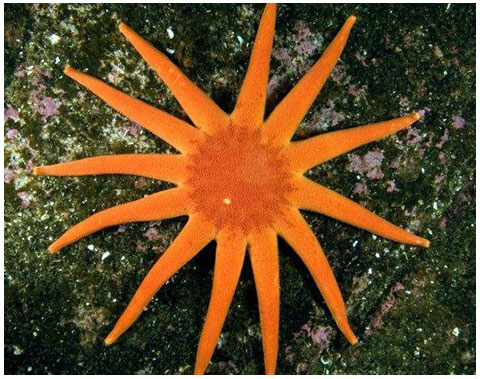
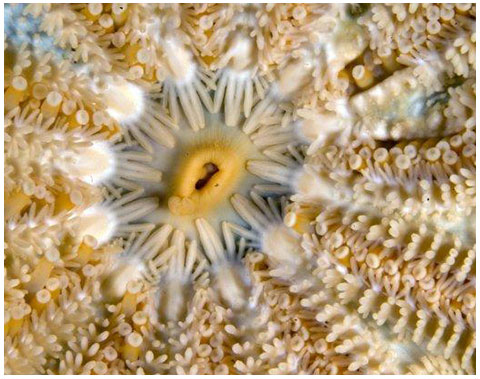
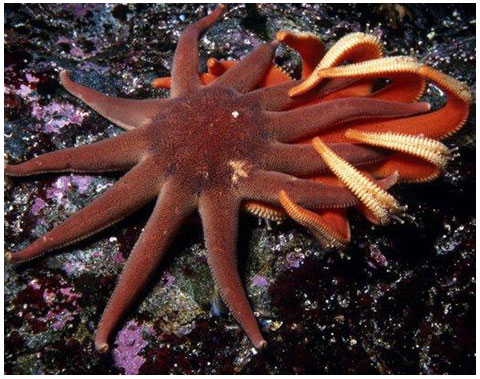
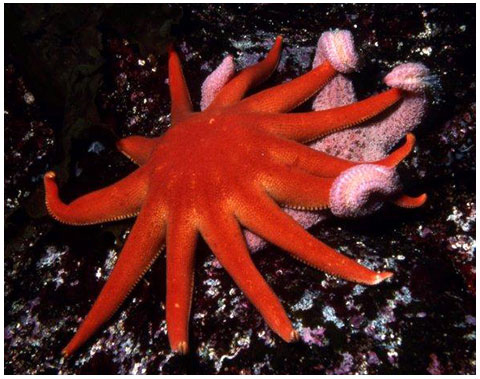
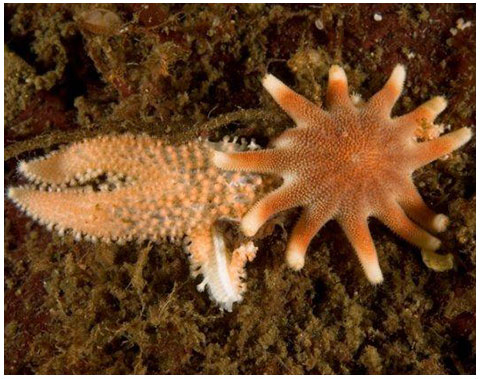



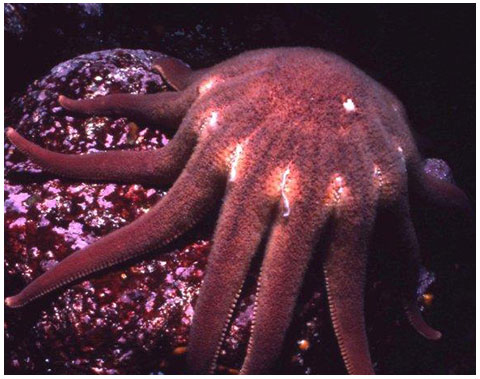
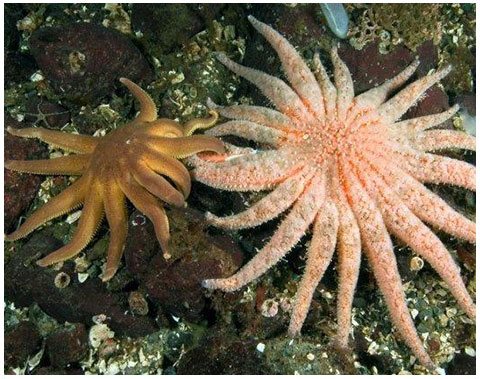

A typical MORNING SUN STAR. Note the smooth surface and gradually tapering arms.
The other common colour phase: orange. In Jervis Inlet I found brown specimens outnumbered orange ones 2:1.
The oral side of the MORNING SUN STAR. Note the broad and shovel-like paired mouth plates. There are 9 to 11 spines along each edge while the apical spine is the longest.
Cannibalism in action: a brown MORNING SUN STAR attacks an orange MORNING SUN STAR. The attacked star folds its arms back in an effort to push away the attacker.
A GIANT PINK STAR is attacked. Note how it coils its arms back to bring its mini-pincers to bear on the attacker.
A CRESTED STAR has been partly eaten by a small MORNING SUN STAR only 5 cm (2 in) across.
A VELCRO STAR under attack. These long-armed, spiny stars fight back aggressively with their thousands of skin pincers and usually escape.
A MORNING SUN STAR has captured a BLOOD STAR far larger than itself.
A STRIPED SUN STAR is attacked. In Puget Sound this species is quite often the target of the MORNING SUN STAR. It takes the MORNING SUN STAR about two weeks to consume a meal this size.
Examine the "armpits" of this MORNING SUN STAR. Slender streams of sperm are being released. Most sea stars hump up like this when spawning, usually in the spring.
Under attack by a MORNING SUN STAR, a SUNFLOWER STAR speeds away but at the same time detaches one arm to evade the predator. Look carefully in the centre of the picture and you can see the sacrificed arm.
This MORNING SUN STAR has been digesting part of a SUNFLOWER STAR.
1 - 12
Previous
NEXT
Notes:
This voracious predator might better have been more aptly named the DEATH STAR because it eats other sea stars. Almost every sea star found in the PNW exhibits a dramatic escape response when touched by the MORNING SUN STAR. Most increase their rate of movement significantly, trying to outrun the predator. But some stars, such as the LEATHER STAR and the PURPLE STAR, are “slow pokes” and readily captured. In field studies I carried out in Jervis Inlet, BC, the LEATHER STAR comprised 50% of stars being eaten. This corresponded directly to the high abundance of LEATHER STARS in this area.
Other stars, such as the LONG-ARMED RAINBOW STAR and VELCRO STAR fight back aggressively, coiling pincer-laden arms around the arms of the MORNING SUN STAR, inflicting thousands of nips. The SLIME STAR is very slow, so attempting to outrun its attacker is impossible. Instead, it inflates its plump aboral surface, preventing the predator from getting a grip while releasing mucous too.
Although it seldom reaches even one-third the diameter of a large SUNFLOWER STAR, touch by a MORNING SUN STAR will elicit an impressive "running" response from a SUNFLOWER STAR. The reaction is based entirely upon the chemical "smell" of the MORNING SUN STAR , since a SUNFLOWER STAR will run no matter how small (and in reality, insignificant) the attacker.
INTRODUCTION | ABOUT SEA STARS | BIOLOGY | SPECIES | PREDATORS / PREY | SEA STAR WASTING DISEASE | ACKNOWLEDGEMENTS | FIELD GUIDE | VIDEO
Copyright © 2018 All rights reserved.